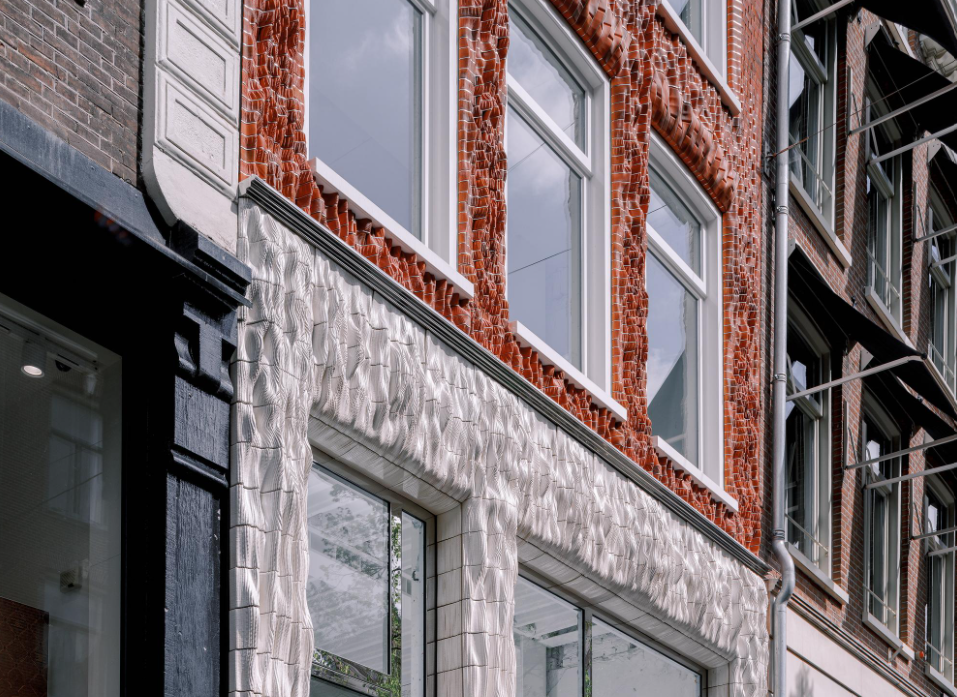Rotterdam-based firm Studio RAP has unveiled an innovative project in the heart of Amsterdam’s upscale shopping district.
Located at 32 P.C., the three-story townhouse-style building has undergone a radical transformation, catching the attention of passersby with a subtle yet noticeable ripple on its facade. The design results from Studio RAP’s integration of computational design, specialized robotics, and ceramic craftsmanship. From the second floor to the street level, the facade comprises custom ceramic tiles algorithmically designed and 3D printed.

A glimpse into the future of architecture
Studio RAP’s approach stands out for leveraging computational design tools to generate intricate patterns inspired by textiles, weaving, and stitches. Lucas ter Hall, Co-Founder of Studio RAP, underscores that, while the design is rooted in computation, the ultimate focus remains on the physical realization of the end product. The result is a facade that mirrors traditional bricks and tiles but incorporates an additional layer of complexity and allure.
Large industrial robots within a vast warehouse at Studio RAP translate algorithmically generated designs into tangible objects. For the Amsterdam storefront, tailored algorithms were meticulously crafted to produce a rippled form similar to textile weaves. Designers invested considerable time fine-tuning the algorithmic design to align seamlessly with 3D printing and clay glazing processes, ensuring the finished tiles authentically resembled textured cloth.
Studio RAP’s software was used to generate robot tool paths aligned with the designed geometry, while specialized nozzles were developed to ensure a high level of detail in the 3D printed tiles, each requiring approximately 45 minutes to print. Ter Hall highlights that understanding the capabilities of the robots allows for more expressive design possibilities. The upper section of the facade adheres to city regulations, replicating the shape and color of conventional bricks to harmonize with the surrounding buildings.
The Amsterdam storefront represents just one facet of Studio RAP’s exploration into 3D printed architecture, says the company. The firm previously garnered attention for its design of a bold blue ceramic treatment for the interior of two vaulted gates in Delft. Ter Hall notes that Studio RAP is actively involved in additional projects using the same innovative technique, with expectations of reducing both time and costs. The ultimate goal is to undertake larger and more complex projects, pushing the boundaries of this novel technology.
3D printing beautifies the construction sector
In alliance with Mumbai’s additive manufacturing solutions provider Simpliforge Creations, Hyderabad-based construction firm Apsuja Infratech built the world’s first 3D printed temple in Siddipet. The 3,800 sq ft, 30 ft high structure aimed to halve construction time, completed in 2-3 months.
Simpliforge’s robotic 3D printing facility, South Asia’s largest, employed an in-house system, materials, and software for the intricate design. The dome-shaped temple, dedicated to various deities, presented challenges, with completed sections including a Modak-shaped sanctum and a square Shrine.
Construction companies BAM and Weber Beamix unveiled the UK’s largest concrete 3D printed staircase for a footbridge over Scotland’s M8 motorway. Working with Glasgow City Council, BAM employed 3D printing to reduce costs, lower carbon footprint, and enhance design flexibility.
Partnering with Weber Beamix, BAM 3D printed intricate stairs off-site, minimizing material use by 40%. The controlled environment ensured structural strength, weather immunity, and integration of sensors for quality monitoring. Connecting Glasgow to Sighthill, the footbridge signifies a construction technology leap, prompting potential broader applications in the UK.
What does the future of 3D printing for the next ten years hold?
What engineering challenges will need to be tackled in the additive manufacturing sector in the coming decade?
To stay up to date with the latest 3D printing news, don’t forget to subscribe to the 3D Printing Industry newsletter or follow us on Twitter, or like our page on Facebook.
While you’re here, why not subscribe to our Youtube channel? Featuring discussion, debriefs, video shorts, and webinar replays.
Are you looking for a job in the additive manufacturing industry? Visit 3D Printing Jobs for a selection of roles in the industry.
Featured image shows Studio RAP’s innovative facade blends tradition and technology in Amsterdam. Photo via Studio RAP.


